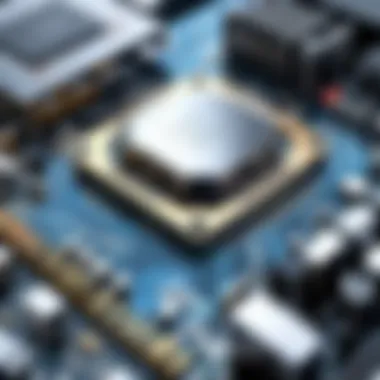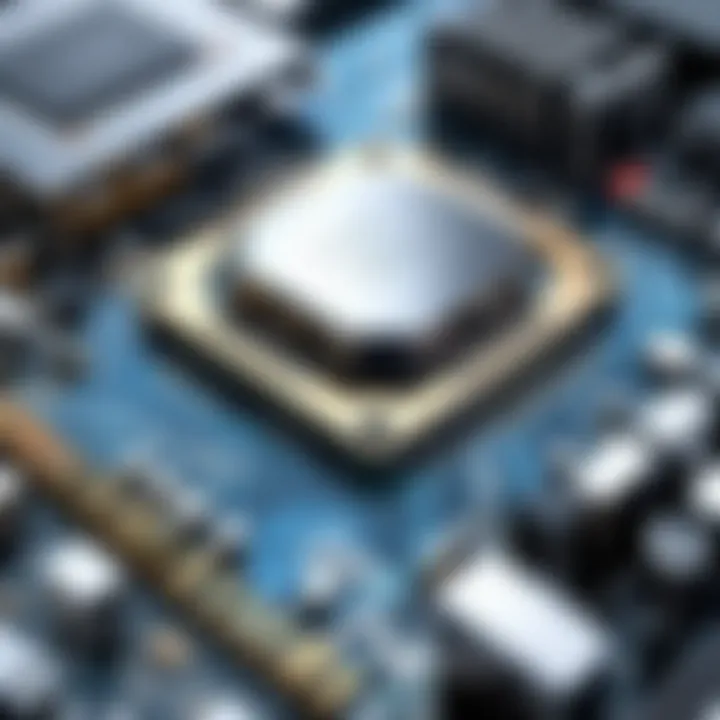Enhance Your Computer's Speed: Proven Optimization Techniques


Intro
In today’s digital landscape, optimizing computer performance is key for various users. People of all skill levels are impacted by how well their systems function. Proper speed matters not just for productivity but also for security. Understanding the relationship between computer performance and online security can amplify protection and efficiency.
Overview of Cyber Security Threats
A critical component of performance enhancement entails being aware of cyber security threats. These risks compromise computer efficiency and user safety in various ways.
Types of cyber threats
- Malware: A type of software designed to disrupt, damage, or gain unauthorized access to systems. Malware can slow down computers by consuming resources.
- Phishing: Attempts to bait users into providing personal and financial information. Successful phishing can have long-lasting repercussions.
- Ransomware: This type invades systems, encrypts data, and demands payment for restoration. Besides being costly, it can incapacitate your systems for extended periods.
Statistics on cyber attacks
In recent years, cyber attacks frequency has risen significantly. For instance, it is estimated that a business suffers a ransomware attack every 11 seconds. This alarming trend sees multiple organizations becoming part of these statistics, often without effective optimization measures in place.
Real-life examples of security breaches
There have been numerous cases that underscore the importance of robust security measures:
- The Target data breach of 2013, where hackers accessed the financial details of 40 million customers, drastically highlighting vulnerabilities in security.
- The massive Equifax breach in 2017, affecting over 147 million individuals, showcased how crucial maintaining system security is.
Best Practices for Online Security
Integrating best practices for online security simultaneously aids in performance. Taking necessary the following steps is crucial:
- Strong password creation: Use combinations of letters, numbers, and symbols. Avoid obvious choices like birthdates.
- Regular software updates: Keeping software current prevents vulnerabilities that hackers often exploit.
- Two-factor authentication: Implementing this adds a layer of protection beyond just passwords, making unauthorized access more challenging.
Reviews of Security Tools
Utilizing effective security tools can facilitate system performance. The right tools also minimize security threats seamlessly. Evaluation of antivirus software effectiveness is essential in identifying the right kind for your system needs. Moreover, comparing firewall protection options helps make informed decisions based on specific needs.
Tips for Ensuring Online Privacy
Maintaining online privacy plays a direct role in performance:
- VPN use: Employ a VPN service to secure online activities from external scrutiny. This crucial step can enhance online anonymity.
- Social media privacy settings: Adjust the safety settings to prevent unnecessary data exposure.
- Protecting personal data: Be vigilant when inputting personal information during transactions to reduce risks of leakage.
Educational Resources and Guides
Empowering oneself with knowledge translates performance losses into gains. Below are useful educational tools:
- How-to articles: These help comprehend encryption setups, contributing to data protection.
- Step-by-step phishing guides: Such precious insights develop better awareness towards intensive email phishing attacks.
Utilizing these methods and understanding current digital threats not only leads to optimized systems but also safeguards user interests against the multitude of risks faced in the online world today.
Understanding Computer Speed
Computer speed plays a critical role in achieving optimal performance in our digital lives. As technology evolves, the demand for faster computation increases, affecting not only productivity but also the overall user experience. Understanding computer speed allows users to identify performance bottlenecks and equips them with the knowledge needed to implement effective enhancements. A well-performing system ensures efficiency, reliability, and the ability to handle sophisticated applications seamlessly, making it essential in today’s fast-paced environment.
Importance of Speed in Modern Computing
In the current age, where multitasking is a common activity, measured speed translates directly into productivity and satisfaction. A speedy computer enables users to run multiple applications without notable lag. This is increasingly relevant for professionals relying on technology for data analysis, graphic design, and software development.
The advent of cloud computing depends heavily on computer speed. Tasks that were previously carried out on local machines can now be executed online, thereby increasing efficiency. Additionally, businesses operate under high-pressure deadlines. Slower devices can lead to distractions that impact workflow, which underlines the pertinence of maintaining good speed. Moreover, a rapid response time enhances overall user experience, making interactions more pleasant.
Common Issues Affecting Computer Performance
There are several common issues that typically impede computer speed:
- Hard drive clutter: Accumulation of poorly organized files and applications can slow down access times.
- Background applications: Unnecessary software running during active hours consume resources and slow the system.
- Insufficient hardware: Outdated or inadequate components, like slow processors or low memory capacity, must be addressed to meet modern software requirements.
- Malware presence: Infections can often reduce performance significantly, affecting both speed and security.
Keeping a superbly optimized and lean system can result in remarkable differences in computer performance. Regular examination and updates ensure consistency in functionality and speed.
Being aware of these issues encourages users to take proactive measures. Better diligence about maintenance habits leads to increased longevity and usefulness of computing devices.
Software Optimization Techniques


Software optimization is crucial for enhancing overall computer performance. Users frequently overlook simple adjustments that can produce significant improvements in speed and efficiency. Understanding these techniques not only helps in optimizing performance but also assists in maintaining a secure and responsive computing environment. Through careful management of software, users can identify resources hogged by unnecessary applications, streamline workflows, and create a more productive digital space.
Clearing Unused Applications
Digital clutter can be just as detrimental as physical clutter. When many applications sit unused on a computer, they often consume important resources, slowing down performance. Regularly reviewing and removing unnecessary applications can lead to more efficient CPU and memory usage.
Uninstalling unused applications not only helps recover storage space but also reduces the potential attack surface for malware. Simple steps involve:
- Reviewing the installed applications list in your operating system.
- Uninstalling those that are infrequently used.
- Deleting old files associated with these applications.
- Regularly conducting this review can prevent accumulation of unused software.
By maintaining a lean application environment, users can facilitate smoother performance and help protect their data integrity.
Managing Startup Programs
Startup programs can sneakily accumulate over time, affecting boot times and general responsiveness. Programs that automatically run upon startup can slow system processing by tying up valuable resources.
To optimize performance, it is helpful to manage these startup applications effectively. The following steps may enhance system efficiency:
- Open the Task Manager or system preferences specific to your operating system.
- Identify applications that start with your system.
- Disable any non-essential applications.
- Temporarily delay those applications needed occasionally instead of removing.
This straightforward approach not only speeds up boot times but also mitigates ongoing resource use, allowing for a swifter computing experience after startup.
Regular Software Updates
Outdated software can become a vulnerability point as developers periodically patch flaws that may expose systems to threats. Regular software updates are vital to keep applications functioning correctly and safely. Neglecting updates leads to instability and security issues.
Here are some critical practices regarding software updates:
- Set applications to update automatically when possible.
- Periodically check for any manual updates, especially for security-sensitive software, such as web browsers or antivirus programs.
- Ensure that your operating system is also routinely updated, to protect against vulnerabilities.
By prioritizing regular updates, users not only enhance functionality but also reduce the likelihood of security breaches, keeping personal information safer over time.
Remember, an optimized software environment significantly contributes to system responsiveness and security.
Disk Management Strategies
Disk management is a crucial aspect of setting up and maintaining an optimally performing computer system. Over time, as files are saved, modified, and deleted, data can become scattered across the storage medium. This fragmentation impacts the speed at which your computer retrieves files, ultimately affecting performance. Moreover, managing the disk's space effectively prevents slowdowns and promotes longevity.
Defragmentation and Disk Cleanup
Defragmentation involves reorganizing fragmented data so that related pieces are physically closer on the disk. This alignment allows the system to read files more efficiently. On Windows, the built-in defragmentation tool automatically optimizes this process on a schedule, but it is prudent to check this manually as needed. It can significantly reduce load times and improve overall file access. In addition, performing a disk cleanup helps in removing temporary files, system junk, and non-essential content that clutters disk space.
To defragment a disk:
- Open the Start Menu and search for "Defragment and Optimize Drives."
- Select the disk you want to defragment.
- Click "Optimize" and wait for it to complete.
Disk cleanup is similarly simple:
- Type "Disk Cleanup" into the Start Menu.
- Choose the drive to clean.
- Follow the instructions to remove unnecessary files.
Utilizing Disk Management Tools
Disk management tools are essential for maintaining an organized and efficient file system. These tools offer insights regarding disk health, storage use, and partition arrangement. Windows, for example, comes with a native tool known as Disk Management. It provides functionalities to create, delete, and format partitions. By properly partitioning disks, users can separate system files from personal data, which can lead to improved performance.
There are also several third-party tools available that enhance or expand the capabilities of the default utilities. Softwares like EaseUS Partition Master or Acronis Disk Director provide a user-friendly interface for managing disk space. These tools can help in analyzing disk usage and suggest adjustments for better performance.
Enhanced awareness of one's disk status can help avoid critical slowdowns while ensuring essential files remain easily accessible. By leveraging these strategies, users not only maintain eye on disk health but also contribute toward a more robust performance of their computer systems.
Memory Management Considerations
Memory management is a crucial aspect of optimizing computer performance. It influences how effectively a system utilizes its resources and directly impacts the speed and responsiveness of applications. By focusing on memory allocation and usage, users can alleviate bottlenecks that slow down their computers. Efficient memory management not only boosts operational speed but also enhances overall system stability.
Identifying Memory-Intensive Applications
To efficiently manage memory, it first helps to identify which applications demand the most resources. By understanding these memory-intensive applications, a user can make informed decisions regarding closing or optimizing them. Common applications that use significant memory include video editing software, graphic design tools, and virtual machines. Running multiple heavy applications simultaneously puts stress on the memory, limiting the performance of other tasks. Examples of tools to identify memory use include Task Manager on Windows and Activity Monitor on macOS. Here are a few steps to assist this process:
- Open the respective monitor tool: Access the relevant activity tool on your OS, like Task Manager (Ctrl + Shift + Esc) on Windows.
- Review memory consumption: Look for the ‘Memory’ column to see how much memory each app uses.
- Prioritize usage: Note which applications consistently use high memory. Consider alternatives that are lighter, or look for ways to optimize their settings.
By pinpointing applications that consume large amounts of memory, steps can be taken to mitigate their impact, thus unlocking higher performance levels.


Adding or Upgrading RAM
Upgrading RAM is an effective solution for improving system performance. Random Access Memory acts as the workspace for your programs, allowing data to be accessed and processed swiftly. Increasing RAM is a practical step to handle demanding tasks comfortably. Here’s why this can matter:
- Improved Multitasking: More RAM enhances a user’s ability to juggle between multiple applications without a lag.
- Reduced Swap Usage: Systems with insufficient RAM use the hard drive as temporary storage, slowing down processes.
- Enhanced Scalability: More RAM permits more programs to run concurrently, accommodating your track of task requirements.
Before upgrading, consider checking the computer specifications to determine the maximum supported RAM. Begin with:
- Assess current RAM usage: Take a look at current memory usage through system monitor tools.
- Choose Right Specifications: Match RAM type and speed with your motherboard.
- Installation: Installing new RAM sticks is relatively easy. However, if unsure, seeking help from a technician might be a good decision.
A proper addition or upgrade of RAM can serve as a significant boost for the system’s performance and will lead to visible differences in speed.
Hardware Upgrades for Performance Boost
Upgrading hardware is often one of the most effective methods to significantly improve computing performance. This focus not only enhances speed but also plays a crucial role in extending the lifespan of your system. The first step in this process is understanding the components that may require attention. Different hardware parts can impact system performance differently depending on usage.
Key hardware upgrades to consider include disks and graphics cards. Both offer valuable benefits, such as faster data access and improved visual processing capabilities. As users rely more on intensive applications for work and recreation, determining when and how to upgrade becomes increasingly relevant.
Solid State Drives vs.
Hard Disk Drives
When discussing storage upgrades, the first point of divergence is usually between Solid State Drives (SSDs) and Hard Disk Drives (HDDs). SSDs use flash memory technology which allows for much faster read and write speeds compared to traditional HDDs. This speed translates into quicker boot times and faster loading of applications. In contrast, HDDs are slower but often less expensive for larger storage capacities.
Most modern systems benefit greatly from SSD upgrades. Tasks such as file transfers, operating system updates, and general file access time are drastically improved. Consider the following situational advantages:
- Compact size: SSDs are generally smaller and use less power.
- Enhanced durability: They have no moving parts, which makes them less susceptible to physical damage.
- Silent operation: SSDs operate without noise.
For users focused on performance, an SSD upgrade emerges as a solid choice, especially when utilizing applications that require rapid data storage and retrieval.
Evaluating Graphics Card Upgrades
Another important consideration for users concerned with performance, especially in gaming or graphic design, is the graphics card. Upgrading to a better graphics card can vastly enhance graphical rendering capabilities. The GPU (Graphics Processing Unit) handles complex computations related to graphics, and a more powerful GPU will manage higher resolutions and better frame rates.
Before choosing a new graphics card, some factors should be taken into account:
- Compatibility with existing hardware—ensure the motherboard can support the new card.
- Power supply requirements—newer high-performance cards may require more power.
- Cooling solutions—higher usage might produce more heat, necessitating enhanced cooling.
Investing in a quality graphics card not only improves gaming performance but can also enhance video editing and 3D rendering significantly.
In summary, hardware upgrades are paramount for elevating both computer speed and user experience. Evaluating options like Solid State Drives and graphics card enhancements gives users clear pathways toward performance improvements. Recognizing needs will lead towards informed purchasing decisions, enabling systems to swiftly handle modern demands for speed and capability.
Operating System Configuration
Operating system configuration plays a crucial role in computer performance. It directly influences how the hardware resources are managed and the overall user experience. Proper adjustments can lead to increased speed, refined responsiveness, and optimized workflows. On the other side, incorrect configurations may result in slow boot times, application lag, and a generally poorer computing experience.
In this section, the focus will be on specific adjustments and settings that can enhance system performance. By optimizing these elements, users can ensure they get the best performance possible from their systems.
Adjusting Visual Effects
Visual effects can greatly impact the performance of a computer. These effects include animations, window transitions, and image smoothing. While they may enhance the aesthetic of the user interface, they consume system resources. On lower-end systems, this can lead to significant slowdowns.
To adjust the visual effects, you have several options:
- Disable unnecessary animations: This can diminish the processor's workload, allowing it to focus on essential tasks.
- Use a basic theme: Switching to a simpler theme can conserve memory.
- Adjust transparency effects: Reducing transparency can enhance performance, particularly for systems with limited graphics capabilities.
Adjusting these settings can lead to impressive improvements in speed. Furthermore, if your main tasks do not require heavy visual capabilities, this adjustment becomes all the more critical. This is an easy way to boost your computer's performance without making complex hardware changes.
By prioritizing essential tasks over visual aesthetics, users can enhance performance levels significantly.
Performance Settings Optimization
Optimizing performance settings within your operating system is yet another way to enhance speed. This involves changing various system level settings to favor performance over energy saving or visual clarity. Here’s what can be done:
- Adjust for best performance: Access system properties settings to prioritize performance under the advanced tab.
- Set a clean startup environment: Modify which programs are running during startup to end background apps that slow the system during boot time.
- Use the device manager: Disable hardware that's not in use, which can free up resources necessary for key applications.
Simple changes like these can considerably streamline how the system operates. Ensure to also perform regular checks, as performance optimal settings can change when new hardware or software is added. Users who remain proactive in this area often see lasting benefits in their machine's performance.
Applying these measures helps in maintaining a lean functioning environment, ultimately concluding in enhanced efficiency and effective computer usage overall.


Impact of Malware on Performance
Malware poses a significant threat to computer performance. To optimize computer systems and enhance speed, understanding how malware functions and recognizing its potential symptoms is essential. Malicious software can consume system resources, degrade performance, and jeopardize online security and privacy. A system infected with malware may exhibit slow responses, numerous pop-ups, or unexpected behaviors. It often leads to frustration among users and causes more extensive vulnerabilities over time.
Effective detection and removal of malware contribute notably to maintaining optimal system health. Furthermore, investing in reliable antivirus software represents a proactive defense against not only current threats but also emergent ones, thereby preserving system integrity and performance. Knowledge about malware and its impact equips users to better safeguard their computers and enhance performance outcomes.
Identifying Malware Symptoms
Awareness of symptoms associated with malware is crucial for any computer user. Common indications include:
- Slow Performance: Unresponsive programs and longer loading times are indicators that malware may be running in the background, draining system resources.
- Frequent Crashes: If applications or the operating system crash frequently without reason, this could suggest the presence of malware.
- Unexplained Pop-Ups: Constant pop-ups, especially those that ask for personal information or promise free downloads, may suggest an infection.
- Unexpected Changes in Browser Settings: Changes such as altered homepage or search engine preferences are classic signs of adware or other malicious software.
- New Programs Without Consent: Discovery of unfamiliar software installed on your system hints at unauthorized access or malware.
Recognizing these symptoms early can prevent further complications and protect your electronic space.
Importance of Antivirus Software
Utilizing antivirus software is an essential component of optimizing computer performance. It offers numerous benefits, including:
- Real-time Scanning: Continuous scanning helps identify and mitigate threats before damage occurs.
- Regular Updates: Antivirus software updates its threat database regularly. This ensures its detection capabilities remain optimized against new and evolving malware.
- Safe Browsing Features: Many antivirus solutions provide additional secure browsing tools that guard against malicious sites.
- Quarantine Capabilities: If malware is detected, the system can effectively isolate it, preventing it from inflicting damage while offering options for deletion or repair.
- Overall System Health Monitoring: Many quality antivirus programs offer diagnostic tools that assess overall system performance, troubleshooting any problems encountered.
Investing in a reputable antivirus solution serves not just as a barrier against threats, but fosters an environment conducive to system optimization. It ensures that users maintain control over their computing performance while remaining safe online.
"Proactivity in managing malware is key to establishing a robust defense around digital operations."
Network Optimization Techniques
Network optimization plays a crucial role in optimizing computer performance. A fast and stable internet connection can enhance not just the usability of applications but also improve overall efficiency. In a world where remote work and online activities are commonplace, slow internet can be a significant bottleneck. By addressing network issues, users can unlock the full potential of their computing devices.
Achieving optimal network performance involves several key strategies. These include evaluating internet connection speed and configuring router settings effectively. Addressing these aspects not only promotes a smoother online experience but also helps mitigate risks associated with network security and privacy.
Evaluating Internet Connection Speed
Understanding the speed of your internet connection is vital. This is often the first step in network optimization. Many become frustrated with slow download and upload rates. Evaluating connection speed provides clarity on whether the issue lies with the service provider or local equipment.
- Use Speed Test Services: Websites like Ookla’s Speedtest or Fast.com are reliable for testing bandwidth. They offer detailed insight into download and upload speeds, plus latency.
- Conduct Regular Tests: Regularly monitoring connection speed helps in identifying patterns. It is helpful to perform tests at different times of day, as speeds may fluctuate depending on peak usage times.
- Raise Awareness of Package Limits: Users should check with their internet service providers about bandwidth limits tied to their plans. Sometimes, upgrading to a higher-speed package becomes necessary to meet demanding usage needs.
In essence, understanding your connection speed equips you to tackle related issues more effectively.
Configuring Router Settings for Optimal Performance
Router settings greatly influence network performance. Properly configured routers ensure that all connected devices can utilize their bandwidth enefficiently.
- Update Firmware: Keeping router firmware up to date protects against vulnerabilities and enhances performance. Follow the manufacturer's guidelines for updating.
- Change Channel Settings: Wireless interference from neighbors can slow down connection speeds. Adjusting the Wi-Fi channel used by the router can help minimize interference. Using tools like inSSIDer can identify the best channels.
- Enable Quality of Service (QoS): QoS settings prioritize traffic coming from specific applications. For instance, during a video conference, it is better for video data to have a higher priority over others like file downloads.
- Review Security Settings: Ensuring that the network uses strong encryption, such as WPA3, can enhance security. By preventing unauthorized access, it maintains optimal performance and protects personal data.
Optimizing router settings not only improves speed but also secures your home network against unauthorized access.
By regularly evaluating both internet speed and router settings, users will see better performance in their computing devices, paving the way for an enhanced experience overall.
Maintaining Long-Term Performance
Maintaining long-term performance of a computer system is critical. Systems require consistent upkeep to function properly over time. Users frequently overlook this facet, which can lead to a gradual decrease in speed and efficiency. Ensuring optimal performance becomes essential as technology becomes more integrated into daily life.
A well-maintained computer will likely perform better, run software more efficiently, and experience fewer crashes. Further, fostering a long-term approach minimizes potential security vulnerabilities. Regular maintenance also extends the lifespan of hardware components. Keeping important files organized aids in better application management, and thus enhances overall experience.
Creating a Regular Maintenance Schedule
Establishing a regular maintenance schedule is fundamental for optimal system performance. It provides a structured approach to keeping your computer healthy.
Tasks to include are:
- Disk Cleanup: Remove unnecessary files such as temporary internet files or cached data. This helps free up space.
- Software Updates: Ensure all applications and systems are updated. This not only repairs bugs but enhances security.
- Defragmentation: If using a hard disk drive, defragment regularly. This is essential for file organization and can improve access speed.
- Check for Malware: Regularly scan your system to detect any malware that could impair usage.
Utilize calendars or automated tools to assist in scheduling these tasks. Consistency is key. Regular maintenance schedules ensure tasks are not forgotten, helping in sustaining performance.
Monitoring System Performance Trends
Observing performance trends can be incredibly beneficial for diagnosing and addressing issues. Keeping track of system performance will allow for proactive adjustments. Common performance markers include:
- Startup Times: Significantly increased startup times may signal issues.
- Application Loading Times: Slower application loads could indicate bloat or memory allocation inefficiencies.
- System Crashes or Slowdowns: These usually precede regular failures, so tracking them is crucial.
Implement monitoring tools or built-in task managers. Access to resources like reddit.com can provide community knowledge on the best tools. Make sure to analyze results over time to spot any negative changes.
A thorough approach to maintaining and monitoring systems will optimize performance, especially for users conscious of security and efficiency.
Regularly refining your skills and understanding of maintenance best practices ensures that the system performs at its best for the longest time possible.







